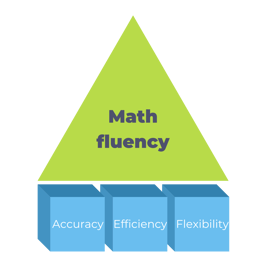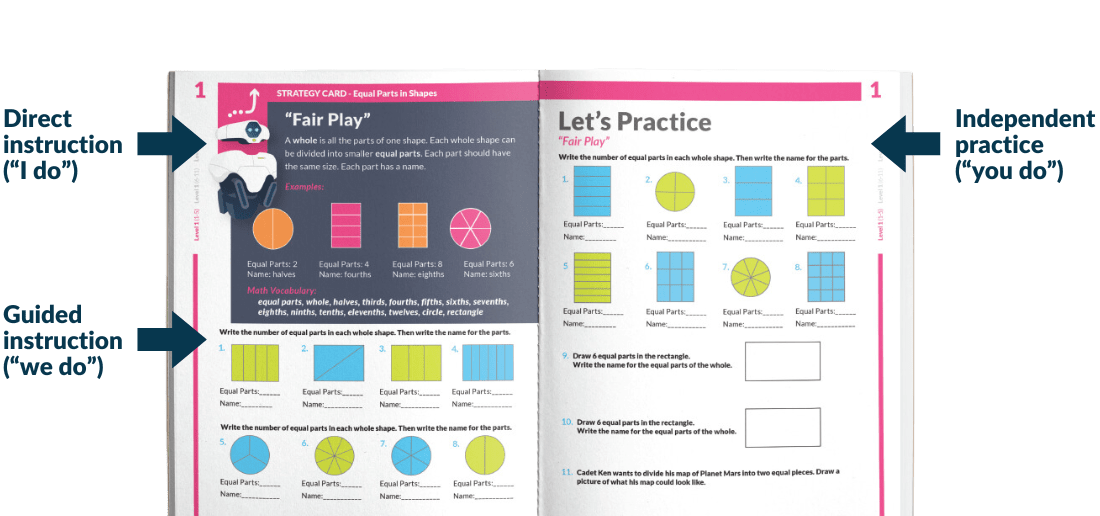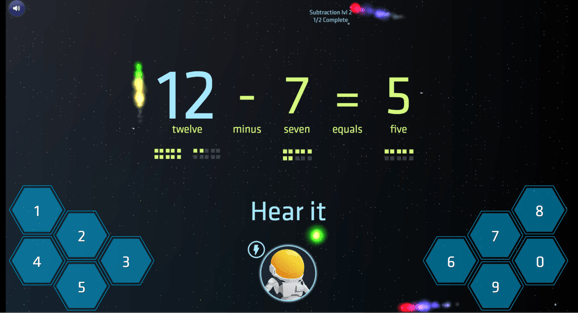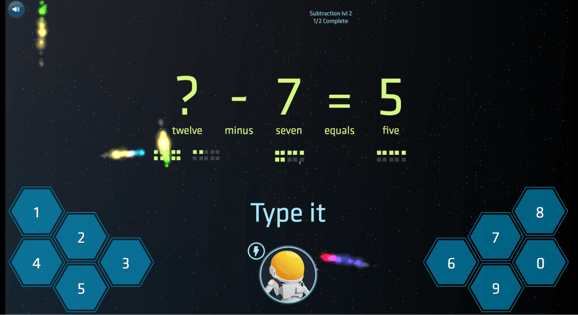A guest post from the math experts at BlueStreak Math
The past 15 years have been revolutionary in our understanding of student learning, especially in mathematics. As new studies emerge on the impact of fluency on student performance and researchers identify more impactful ways to support and sustain learning, it’s critical that we refresh our understanding of math fluency and adapt our methods for teaching math to maximize student success.
Math Fluency vs. Math Fact Fluency
The definition of fluency has shifted significantly in recent years, but for many, “math fluency” is still used interchangeably with “math fact fluency.” The reality, however, is that the latter is only one piece of true math fluency.
Math fact fluency is essentially automaticity, or the ability to quickly recall from memory the answers to common “math facts,” such as 2+2 or 5x7. While there is certainly a place for automaticity in student learning, an over-emphasis on this piece of math fluency can cause educators to rely too heavily on rote memorization and ultimately lead to math anxiety.
Math fluency, on the other hand, is a much broader range of skills – including both fact fluency and procedural fluency – and acts as the underlying foundation for students’ long-term success in mathematics. While automaticity is one of its components, math fluency also aims to help students flexibly apply their learnings and make connections between different mathematical concepts.

This type of learning not only propels students toward success in more advanced mathematical subjects, but also builds their confidence and contributes to a positive attitude toward the subject.
How To Leverage a Comprehensive Approach To Build Math Fluency
A comprehensive approach is about considering all facets of math fluency to build the strongest possible foundation for students to thrive in mathematics. It’s about adopting a strategic and research-based process to address the unique needs of each student and allow each to progress, no matter their starting point.
Here are a few ways to begin taking a more comprehensive approach to math fluency in your district or school:
1. Make automaticity practice engaging.
Automaticity – the part of fluency that emphasizes accuracy and efficiency – has gotten a bad rap in the past due to its associations with math anxiety. It’s not surprising: automaticity was often achieved through “drill and kill” methods that made students dread math. The truth, however, is that automaticity is critical for student growth on high-stakes assessments. In many states and grade levels, these assessments are timed, do not allow calculators, and feature multi-step questions, meaning students need to master automaticity to meet minimum acceptable standards.
So, how do we support this type of learning while building student confidence rather than breaking it down? The answer is simpler than you’d imagine: just make timed practice fun! Rather than presenting students with worksheets of equation after equation, use games that mirror the ones students play outside of school (think: Pac-Man and Galaga) that apply a timed component in a non-anxiety-inducing way.
Example: BlueStreak Math features competitive and cooperative multiplayer games to up the engagement ante. They allow all students to play together even while receiving personalized practice within the game, so all students have an opportunity to participate and win, regardless of academic level.
2. Use Gradual Release of Instruction to Teach new strategies and develop numeracy.
While accuracy and automaticity are key building blocks of fluency, it’s also critical to support students’ ability to flexibly apply strategies and develop numeracy, guiding them toward procedural fluency.
But learning new strategies and concepts can be intimidating for students, and misunderstandings are far from uncommon. Our biggest tip? Structure lessons in a way that allows you to identify and correct misconceptions in real-time – it’s a whole lot quicker in the long run than trying to do so down the road when these misconceptions are more cemented in students’ brains.
That’s where the gradual release model comes in. By adopting the “I do, we do, you do” approach to teaching new strategies, we provide structured support that minimizes windows for error and builds student confidence.
Example: BlueStreak’s Strategy Logs provide turnkey, scripted lessons that follow this framework for an ultra-low lift approach:

3. Stimulate the senses.
Research shows that multi-modal instruction enhances understanding and retention by creating neurological signals that impress multiple parts of the brain, ensuring backup support to the memory system (Salimpoor, 2016). It also helps cater to different learning styles and boosts student engagement.
At BlueStreak, we use a Brain-Compatible Multimodal Sensory Impress Method to teach new strategies with Learning Cards. While BlueStreak takes the burden for planning multi-modal instruction off of teachers, it’s an approach any educator can adapt to their own school or classroom:
- See It: Visual component stimulates the Occipital Lobes for vital brain imagery.
- Hear It: Auditory component stimulates the Temporal Lobes by hearing the sound of language.
- Say It: Vocal component activates the motor cortex in the Parietal Lobe and the hearing in the Temporal Lobe by the sound of the student’s own voice as they say the words aloud.
- Type It: Bodily/Kinesthetic components activate the integration of the senses in the Motor Cortex located in the Parietal Lobe, creating powerful and lasting muscle memory.
- Solve It: Thinking and reflecting awaken the critical Frontal Lobes of the brain to perform the executive functions of cognition that include analyzing, evaluating, perceiving, comprehending, and connecting.


4. Apply a deliberate practice model
“Deliberate practice” oscillates between periods of “appropriately challenging” practice with immediate feedback, and rest and reflection to maximize skill-building. Research shows it is a profoundly effective method for learning everything from the piano to sports to math fluency.
To integrate deliberate practice into your math fluency instruction, consider the following:
- Utilize adaptive digital tools such as BlueStreak Math to provide personalized learning and practice for each student, so each is challenged rather than speeding ahead of or lagging behind their peers, which will limit growth.
- Find methods to provide students immediate feedback on practice problems so they know right away whether their answer was correct rather than waiting for their worksheets to be reviewed.
- Prompt students to reflect on their learning and practice and set goals for themselves to enhance understanding and stimulate memory. See these sample pages from BlueStreak Math’s Strategy Log workbooks for example prompts.
BlueStreak was built on a deliberate practice model to support maximum student growth while building their confidence.
5. Support learning for all students with flexible grouping.
Flexible grouping is an instructional strategy in which students are grouped and regrouped based on their current skill levels and/or learning styles. Its goal is to provide personalized and targeted instruction that meets the diverse needs of students and supports their individualized learning journeys.
The key to utilizing flexible grouping effectively is data; without it, students cannot be grouped and regrouped in real time to adequately support their learning needs. While there are ways to achieve this without the support of digital tools, these methods are often time-intensive for educators. For this reason, we recommend leveraging tools that gather and interpret data on your behalf, in real-time.
Example: BlueStreak supports low-lift flexible groupings through its Intervention Grouping Tool, which automatically groups students by skill based on real-time data. Teachers can then break students out into groups to learn and practice together using corresponding pages in BlueStreak’s Strategy Log workbooks.
Closing:
At BlueStreak, we have heard countless educators’ reluctance to emphasize math fluency in the classroom due to an outdated idea of what math fluency is and how it’s achieved. But the definition of math fluency has shifted drastically, and the research is clear: fluency is critical to students’ confidence and long-term success in mathematics.
Luckily, by applying the latest research to how we approach math fluency in the classroom, we really can get the best of both worlds. By applying methods like those outlined above, we can build a better foundation for our students and set them up for a bright, anxiety-free future in mathematics.
Key Takeaways:
- Math fluency is critical to success, and can be effectively taught with innovative, engaging strategies.
- The definition of math fluency has expanded to include both fact fluency and procedural fluency.
- Flexible grouping in real time based on student skill level leads to better outcomes in math.
About the Authors

|
Catherine Duncan | CEO and Founder, BlueStreak Math Catherine Duncan is president of BlueStreak Education, Inc., an Illinois- based educational software company focused on innovative math solutions for all students. With more than a decade of educational consulting experience, Catherine has collaborated with thousands of educators to advise on the selection, implementation, and use of educational solutions for improving classroom instruction and student performance. |
 |
Sara Naatz | Director of Marketing, BlueStreak Math Sara Naatz leads BlueStreak Math’s marketing program, helping spread the word about BlueStreak’s revolutionary approach to math fluency to schools across the United States and abroad. |
About Bluestreak Math:
BlueStreak Math is a comprehensive math fluency solution that leverages an adaptive digital solution, automatic intervention groupings, and scripted lessons for a low lift, high impact approach to math intervention. Its "fluency 2.0" approach extends beyond whole numbers to fractions and decimals, making it a popular choice for both elementary and middle school interventions.
Built on a research-based foundation of deliberate practice, BlueStreak aims to develop numeracy skills and increase student accuracy, efficiency, and flexibility while minimizing math anxiety. Research shows that students who complete at least one level with BlueStreak Math experience 2-3x the high-stakes assessment score growth of those who don't.
About the author
Guest Author

Your MTSS Transformation Starts Here
Enhance your MTSS process. Book a Branching Minds demo today.


















.png?width=716&height=522&name=Tech-Learning-Most-Influential-Edtech-Product-2025(preview).png)